Positive Health Online
Your Country

This mighty muscle has a profound influence upon our well-being
At the very core of your physical body lies a muscle that influences every aspect of well-being. The psoas muscle, critical for balance, alignment, joint rotation and range of motion, also influences the circulatory system, the functioning of organs and diaphragmatic breathing. The only muscle to link the lumbar spine to the legs, it is a dynamic psoas that massages your vertebrae, viscera and organs with every walking step.
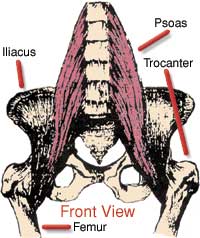
The Psoas (front view)
Fear and the Psoas
As part of the instinctive fear reflex the vitality of the psoas muscle reflects your personal sense of safety. When feeling threatened it is your psoas muscle that propels you into fleeing or fighting or curls you into a protective ball. Trauma or chronic abuse can eventually cause the contracted psoas to lose its motility. Learning to sense your own psoas can bring you in contact with your deepest fears, but more profoundly it connects you with the instinctive wisdom that dwells within the belly core.
The Belly and Pelvis
Connecting to the inner core enriches your life, quiets your thoughts and reconnects you with the larger web of life energy. Learning to release and engage the psoas brings you directly in contact with your instinctive wisdom. Referred to in ancient traditions as the hara, dan tien and Buddha belly, your gut feelings empower and guide your personal choices and spiritual path.
The combination of aligning your body with gravity and increasing your inner awareness facilitates a healthy psoas muscle. If you envision your spinal column as an electrical conduit, receiving, transmitting and transmuting subtle life energies, then your psoas muscle is the grounding wire. Released and supple, a dynamic psoas grounds and connects you to the earth.
The sensation of being centred and grounded comes from a healthy psoas in combination with a balanced weight-bearing pelvis. The keystone of skeletal alignment, it is the balanced pelvis that provides a base of support for the spine, ribcage, neck and head. It is the aligned pelvis that transfers weight down through the hip sockets, legs, knees and feet. If the bones do not support and transfer weight properly, it is the psoas muscle that is called upon to provide structural support.
A Guy Wire
A healthy psoas provides a suspension bridge between trunk and legs. In the same way that guy wires of a circus tent help maintain the stability of the centre pole, the psoas responds to every movement of the spine. Ideally the psoas guides rather than bears the transfer of weight from the one (trunk) into the two (legs). However, when the pelvis is unstable or off balance the psoas muscle must substitute and maintain stability. When chronically used as a structural support the psoas eventually loses its range of motion, flexibility and strength. Over time the muscle begins to shorten.
The Shortened Psoas
Because the psoas contracts and releases at each of its joint attachments it has the ability not only to stabilize but also to torque, rotate and twist the spinal vertebrae, pelvis and legs. A short psoas tips the pelvic bowl forwards. Minimizing the space between the crest of the pelvis and the leg compresses the hip socket, preventing the leg from moving separately from the trunk. Normal rotation, instead of occurring in the ball and socket of the hip joint, begins to manifest as twists in the knees and torques in the lumbar spine.
Chronic muscular tension, overdeveloped external muscles, and muscular substitutions can be linked to a tense or overworked psoas. Birth anomalies, falls, surgery, overexuberant stretching or weightlifting may create pelvic instability or affect the functioning of the psoas muscle. However, like the chicken and the egg koan, whichever comes first – a short psoas muscle or an unstable pelvis – the problems that arise are the same: limited pelvic volume, constricted organs, impinged nerves and impaired diaphragmatic breathing. Putting pressure on the uterus, a tense or short psoas can cause cramping. Pushing the oesophagus forwards, a tight upper psoas can cause digestive problems. A short psoas can interfere with the diaphragm fully descending through the abdominal core.
The Supportive Psoas
It is the length and vitality of the psoas that helps to maintain volume in the core. Providing a diagonal muscular shelf, the psoas moves through the core supporting the abdominal organs. A major ganglion of nerves is located on top, around and imbedded through the psoas. Together with the diaphragm, the action of the psoas works like a hydraulic pump to massage the organs and viscera while stimulating the flow of fluids throughout the body. Deeply set at the twelfth thoracic vertebra, the psoatic shelf moves through the core, surfacing in the front of the pelvis and lengthening over the hip sockets where it joins the iliacus in a common tendon. It is right at the hip sockets where it is easiest to locate and sense your own psoas muscle.
Locating Your Psoas
The psoas attaches to the side and towards the front of the twelfth thoracic vertebra and each of the five lumbar vertebrae. It moves through the pelvic girdle and inserts along with the iliacus (a fan-shaped muscle lining the inside of the pelvic bowl) in a common tendon at the lesser trochanter of the femur (the thigh bone near the groin area). The psoas and iliacus combine to form a muscle group called the iliopsoas.
To locate your psoas imagine peeling the layers of your body like an onion. The first layer is your skin. Next, the abdominal muscles in front and lumbar muscles at the back. The large intestines come next and another layer of back muscles. Below this level are the small intestine, the reproductive organs, abdominal nerve ganglia and major arteries. From behind the deepest of organs the kidneys rest on and to the side of the psoas. In the centre of your skeletal core is your psoas muscle.
Ergonomics and the Psoas
Everything from the chairs we sit in to the shoes we wear can curtail the natural movement of the psoas. Having a constricted psoas might be traced back to your first shoe. Wearing a shoe that shapes the foot, stops bones from rolling, limits ankle mobility, drops the heel behind or shifts the weight onto the toes can and does affect skeletal balance. It can stifle the vitality of your psoas.
Premature standing and walking (before the bones are fully formed and weight bearing) teaches a child to rely on their psoas muscle for structural support. Playpens and walkers encourage early standing and limits crawling, which is so important for kinaesthetic maturation. Plastic baby holders restrain and limit natural movement, rhythm and the protective give and take of a mother's supple body.
Releasing the Psoas
Releasing tension in your psoas realigns the way you experience yourself in the world. Sensing your bones bearing weight translates into a physical sensation and an emotional feeling of 'standing on your own two feet'. Learning to let the psoas be supple is the first step in shifting a dependency on muscular support to skeletal stability.
At first it can be difficult to access the subtle sensations of the psoas. Buried deep within, often engaged in habitual postural patterns and linked to your emotions, it can take a great deal of patience, perseverance and quiet attention to sense your psoas and experience the core. Awareness is the first key. Just as a flashlight can clarify what is in a dark closet, so too your awareness can give definition to your internal sensations. Each time you are attentive to your inner sensation your awareness increases. At first it may only be vague or acute tension that you sense, but eventually you will begin to distinguish and perceive the difference between muscle, ligament, tendon and bone.
A good position to work in is the constructive rest position. A safe, comfortable position, it helps to relieve back, pelvic and leg tension by releasing the iliopsoas. To try the constructive rest position, begin by resting on your back. Keep the knees bent and the feet placed parallel to each other, the width of the front of your hip sockets apart. Place your heels approximately 12-16 inches away from your buttocks. Keep the trunk and head parallel with the floor. If not parallel place a folded, flat towel under your head. DO NOT push your lower back to the floor or tuck your pelvis under in an attempt to flatten the spine. Rest in the position for 10-20 minutes. As you do, the psoas will begin to release, the pelvis will spontaneously extend and the spine will lengthen. Keep the arms below shoulder height, letting them rest over the ribcage, to the sides of your body or on your pelvis. In this simple position gravity releases the psoas.
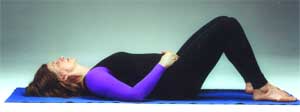
Releasing the Psoas Muscle while in the Constructive Rest position
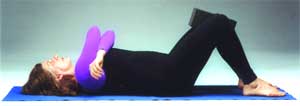
Leg support in the Constructive Rest position
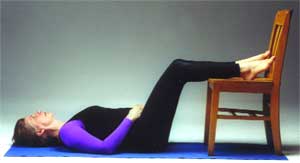
Constructive Rest position
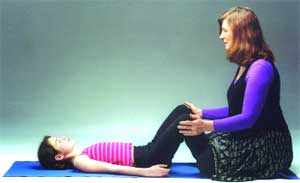
Supporting client releasing their own Psoas muscle while in the Constructive Rest position
Case Studies
Case Study 1 – Judy
After a major car accident a woman took my Core Awareness workshop in the hope of re-establishing her skeletal alignment. Judy's physical therapist had identified her structural problem as a constricted psoas muscle. Although therapy had helped, it had not completely resolved Judy's lower back and neck pain. Working in the constructive rest position (see above) Judy began sensing her lower back release and lengthen along the floor. As she explored her psoas muscle she became aware of tension along her spine. I shared with her what a PhD graduate in Structural Physics once told me. He had explained to me that seatbelts, although a life-saving device, stop the psoas muscle from going through its natural spontaneous reflex motion. Instead of rolling into a foetal position, which is the instinctive movement when falling, seatbelts deny the psoas its full range of expression. Rolling of the spinal column when falling makes the spine resilient. It also protects the vital organs – important when receiving a blow. Due to the seatbelt restraint, the lack of spinal movement resulted in stiffness and pain. Releasing the psoas muscle and slowly flexing and extending each vertebra helped to resolve the trauma. The explorations Judy worked with gave her an approach for working at home. She left the workshop feeling more relaxed, empowered and hopeful.
Case Study 2 – Ruth
After 20 years as a teacher and practitioner of yoga, Ruth came to work with me. Her hyper-flexible body was in extreme pain. Ruth's chiropractor had diagnosed her problem as a chronically weak psoas muscle and a destabilized pelvis due to overstretching pelvic ligaments (SI joints). She attended one of my Psoas Intensive workshops in the hope of learning some tips on gaining core strength. I explained to Ruth that I thought core strength ultimately comes from skeletal balance not from tight muscles. However, if her pelvis could not support her weight her psoas muscle would need to stabilize and transfer weight. Rather than having a weak psoas I felt Ruth had an exhausted psoas.
Because a structurally supportive pelvis is vital for developing core strength it was essential first to release her psoas as well as to begin re-establishing pelvic integrity. The best way for Ruth to heal was to stop overextending. Establishing clear skeletal boundaries relieved her pain and actually changed the way she approached her life.
Ruth returned for another workshop. By now she had begun her yoga practice with a new awareness and she had drawn correlations between overextending in her practice with over-extending in her personal and professional life. No longer engaging her psoas muscle as a structural support, she was totally free of pain and experiencing the peaceful feeling that comes from having a supple core.
Case Study 3 – Sam
Previously a weight trainer and athlete, Sam was the owner of a successful Pilates School. As a Pilates instructor he attended a workshop with the intention of expanding his teaching tools for working with his students, staff and clients. Sam was very knowledgeable and skilled, yet he had been taught to engage his upper psoas muscle for structural support when working with weight machines. Now a well-established habit, he still contracted his solar plexus whenever he lifted or extended his arms. Through a variety of sensory explorations Sam played with the concept of not anchoring the core. Anchoring or contracting the upper psoas muscle is a common teaching instruction not only used in some weight training but often found in traditional forms of Western dance instruction.
Getting lift in the ribcage by contracting the upper psoas curtails abdominal breathing and stifles the psoas. After a few explorations Sam began to sense how skeletal support and a supple psoas resulted in a softer and more compassionate stance. This posture more suited his heartfelt desire to help other people. Sam and I worked together to help him articulate the arm (at the ball and socket joint) from the trunk so that moving his arm did not pull on his core. Just as articulating the hip sockets helps to free the legs from the torso, so the arms must be differentiated from the trunk for the psoas muscle to retain its integrity. Sam discovered a fresh approach to teaching Pilates. He eliminated all cues (such as tucking the pelvis, locking joints, compressing the spine) that might encourage anchoring of the psoas muscle. Instead he sought to develop cues that helped people seek a deeper sensation of a supple core.
Case Study 4 – Roger
After bicycling across the United States a young man called me in the hope of attending a workshop upon his arrival in California. In extreme pain Roger had already gone to several physicians as he made his way across the country. Each time he was told his psoas muscle was inflamed and spasmed. A strong-willed young man, Roger was determined he would finish his goal of riding his bike across the United States. I think he expected that a few hours would set him right and he would be on his way.
Working in the constructive rest position did help to relieve much of his hip socket and knee discomfort. We devised several stretches that also counterbalanced the dominant flexing activity of biking. Stretching the hamstrings took tension out of the knees. Stretching the flexor muscles of the thigh helped Roger regain some of his skeletal balance. We discussed the importance of adjusting his bike to allow for full leg extension. Muscularly dominant flexing activities such as biking demand a balance of extension activities: yoga, swimming, walking and other activities would help him regain his muscular balance and keep it.
However, Roger's wilfulness was truly the cause of his problem. He was forced (by pain) to stop all biking until his psoas could heal from the trauma. He recognized how he had accepted the antisomatic idea that 'pain brings gain'. I suggested he look at his life and how and why he made the choices he did. He acknowledged that he did not listen to his gut feelings but pushed past the sensations with sheer willpower. The damage done to his psoas would take time to heal, patience and a new respect for his inner wisdom.
Case Study 5 – Gloria
Sent by her obstetrician, a pregnant woman came to see me with tears in her eyes. Gloria was terrified of birthing and feeling that she just did not have what it took to get a baby out. The baby had not yet positioned itself deep within her pelvis, even though early signs of labour had begun. Gloria's physician recommended that she see me in the hope that I might help her to overcome her fear of birth and avoid having to have a caesarean. Supporting her legs while she learned to release her psoas muscle proved an incredibly powerful and helpful experience for her. Gloria began to relax as she recognized I was not going to 'do anything' to her. Her personal boundaries intact, she began to feel safe. A modified constructive rest position provided her with a simple relaxation tool she could use at home. Feeling relieved, a flood of tears poured from her eyes. She was amazed to find that letting go did not mean that the baby would fall out or come before she was ready. I helped Gloria to identify the energy in the room as birthing energy. The relief and strength Gloria was feeling was in fact her psoas muscle releasing. She felt a powerful surge of energy move down her legs and into her feet. I told her that what she was feeling would sustain her through birthing her baby. Staying in touch with her sensation was empowering. She left feeling strong, capable and ready to face birth. She was so delighted with the results of her session that she invited me to attend the birth! I did and had the delight of witnessing her give in to the power of her belly wisdom. Gloria vaginally birthed a healthy baby daughter.
Case Study 6 – George
A physician at a Pelvic Pain Clinic had invited me to teach a workshop on the psoas muscle. One older man I worked with had extreme pelvic pain. While working together I felt intuitively that there were powerful but suppressed emotional issues with his father; memories that might be locked in the tissue of his constricted psoas muscle. I gently enquired whether that might be true? George told me his dad used to climb on top of him as a little boy and hold him down, forcing him to eat. Rather than be too active with George, I sat next to him and with his eyes open we slowly explored releasing the psoas. My hand served only to help bring and keep his attention on his hip socket while George focused on staying present and in the moment.
Conclusion
Working with the psoas muscle for over 25 years and hearing story after story has confirmed for me the importance, power and need for respect for the psoas muscle. Because of my experience I do not believe in manipulating the psoas. Rather I recommend supporting people in learning to sense and voluntarily release their own psoas. Ultimately acknowledging and demonstrating respect for each person's inner sanctum helps them to regain their personal core integrity. Establishing an inner relationship to your core is both rewarding and everlasting.
Comments:
-
Carol said..
I found your article very informative and hopeful. I appreciate your comments regarding the voluntary release of our psoas, as I have found manipulation through physio and massage to be ineffective.